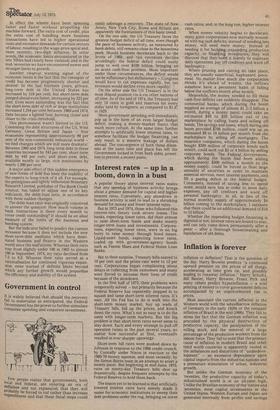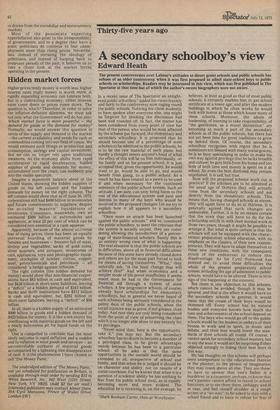Inflation is forever
Inflation or deflation? That is the question of the day. Harry Browne predicts -a continued upward pressure on the prices of all things, accelerating as time goes on, and possibly leading to runaway inflation." Harry Schultz, .Bill Baxter, Harry Browne, Franz Pick and many others predict hyperinflation — a wild printing of money to cover government deficits accompanied by an unprecedented rise in prices.
Most associate the current inflation in the Western world with the wheelbarrow inflation of Germany in the early 1920s or the rampant inflation of Brazil in the mid-1960s. They fail to stress the fact that the German inflation was preceded by the physical destruction of productive capacity, the paralysation of the rolling stock, and the removal of a large percentage of the productive workers from the labour force. They fail to note that the primary cause of inflation in modern Brazil and other third world countries is apparently rooted in the imbalances and distortions of -underdevelopment" — an excessive dependence upon capital imports from the industrial nations and a premature stimulation of urban, industrial growth.
But unlike the German economy of the 'twenties, the productive capacity of today's industrialised world is at an all-time high. Unlike the Brazilian economy of the 'sixties and 'seventies, most capital investments in the United States, Western Europe and Japan are generated internally from profits and savings or drawn from the eurodollar and eurocurrency markets.
Most of the pessimists expecting hyperinflation also point to the irresponsibility of governments, and to a degree they have a point: politicians do continue to fear unemployment more than rising prices. Nevertheless, instead of stressing the ideology of politicians, and instead of harping back to irrelevant periods of the past, it behoves us to take a closer look at the market forces operating in the present.
Hidden market forces
Higher prices imply money is worth less; higher interest rates imply money is worth more. A rapidly expanding economy can tolerate both. But in a contracting economy, either interest rates come down or prices come down. The question is, which? Therefore, in order to solve the inflation-deflation dilemma, we must ask not only what the Government will do but also: Which market force is more powerful the demand for goods or the demand for money? Normally, we would answer this question in terms of the supply and demand in the market the current availability and needs for cash or commodities coming into our field of vision. We would estimate such things as production and consumption, savings and capital investment. But we can no longer rely upon traditional measures. As the economy shifts from rapid acceleration to rapid deceleration, hidden supplies of goods and demands for money, accumulated over the years, can suddenly pop into the visible spectrum.
Imagine a mammoth balance sheet of the United States, showing the hidden supplies of goods on the left column and the hidden demands for money on the right column. The left column would show that as of June 30, 1975, corporations still had $400 billion in inventories and future commitments to suppliers, despite the so-called -massive" liquidations of inventories. Consumers, meanwhile, own an estimated $500 billion in automobiles and appliances, at least 25 per cent of which can be considered non-essential in a cash squeeze.
Apparently, because of the almost universal fear of rising prices, there has been an equally universal hoarding of material goods by families and businesses freezers full of meat, shrimp and vegetables; sacks of gold coins, silver quarters, and antiques; inventories of cars, appliances, toys and photographic equipment; stockpiles of lumber, cotton, copper, steel, petrochemicals and petroleum all considered "a hedge against inflation."
The right column (the hidden demand for money) would show that non-financial corporations have $83 billion in cash and equivalent, but $426 billion in short-term liabilities, leaving a "deficit" or a hidden demand of $343 billion. Banks and thrift institutions have $212 billion in cash and equivalent, but $292 billion in short-term liabilities, leaving a -deficit" of $80 billion.
In all, there is a hidden supply of an estimated $900 billion in goods and a hidden demand of $423 billion for money. It is like a ten-storey bin overflowing with material goods on the left and a nearly bottomless pit for liquid funds on the right. One is compelled to conclude that the most likely outcome is rapid deflation and a sudden end to inflation in most goods and services an uncontrollable outburst of material goods accompanied by a lightning-like disappearance of cash. It is the phenomenon I have chosen to call 'The Money Panic.'
The unabridged edition of 'The Money Panic,' not yet scheduled for publication in Britain, is available through mail order by sending $15 to Weiss Research, Inc., 542 West 112th Street, New York, NY 10025. (Add $2 for air mail.) Interested publishers may contact Abner Stein, 39A Cyril Mansions, Prince of Wales Drive, London SWI.



































 Previous page
Previous page